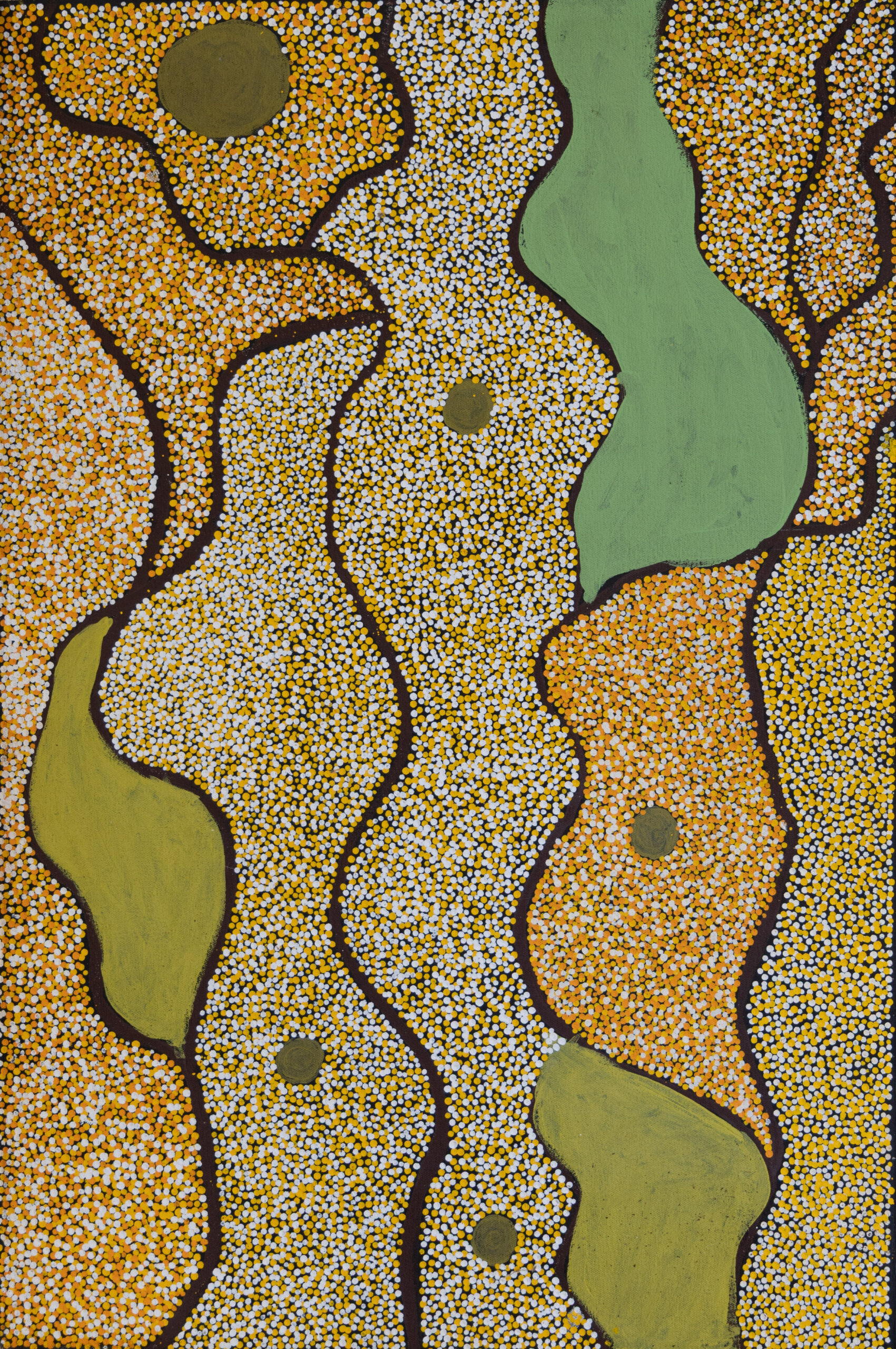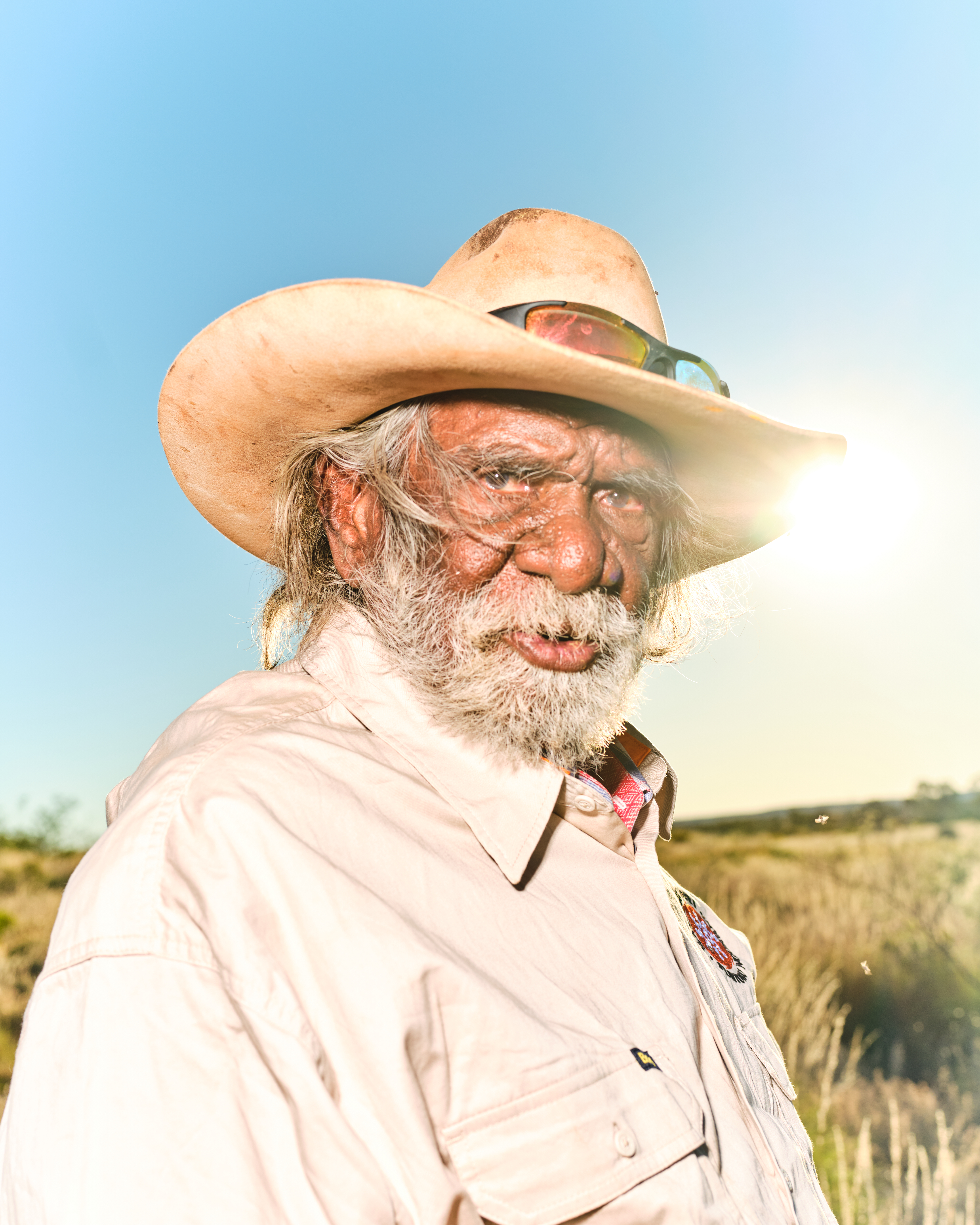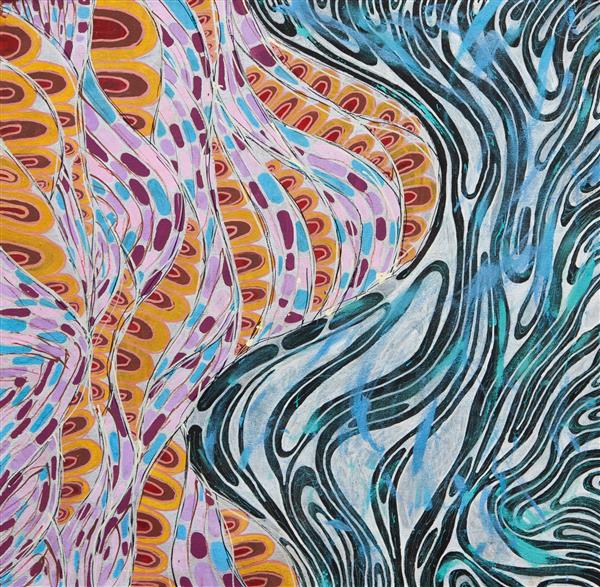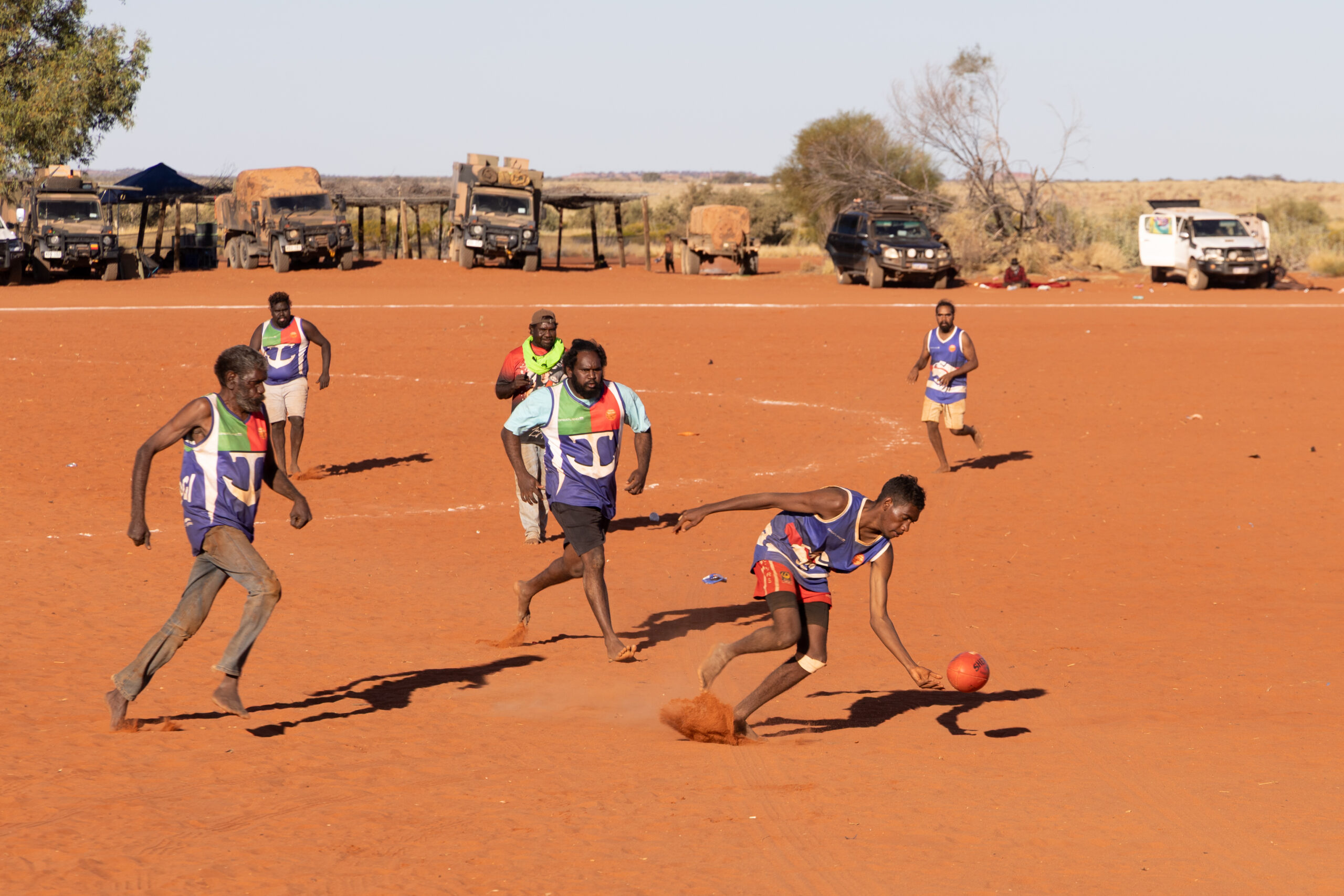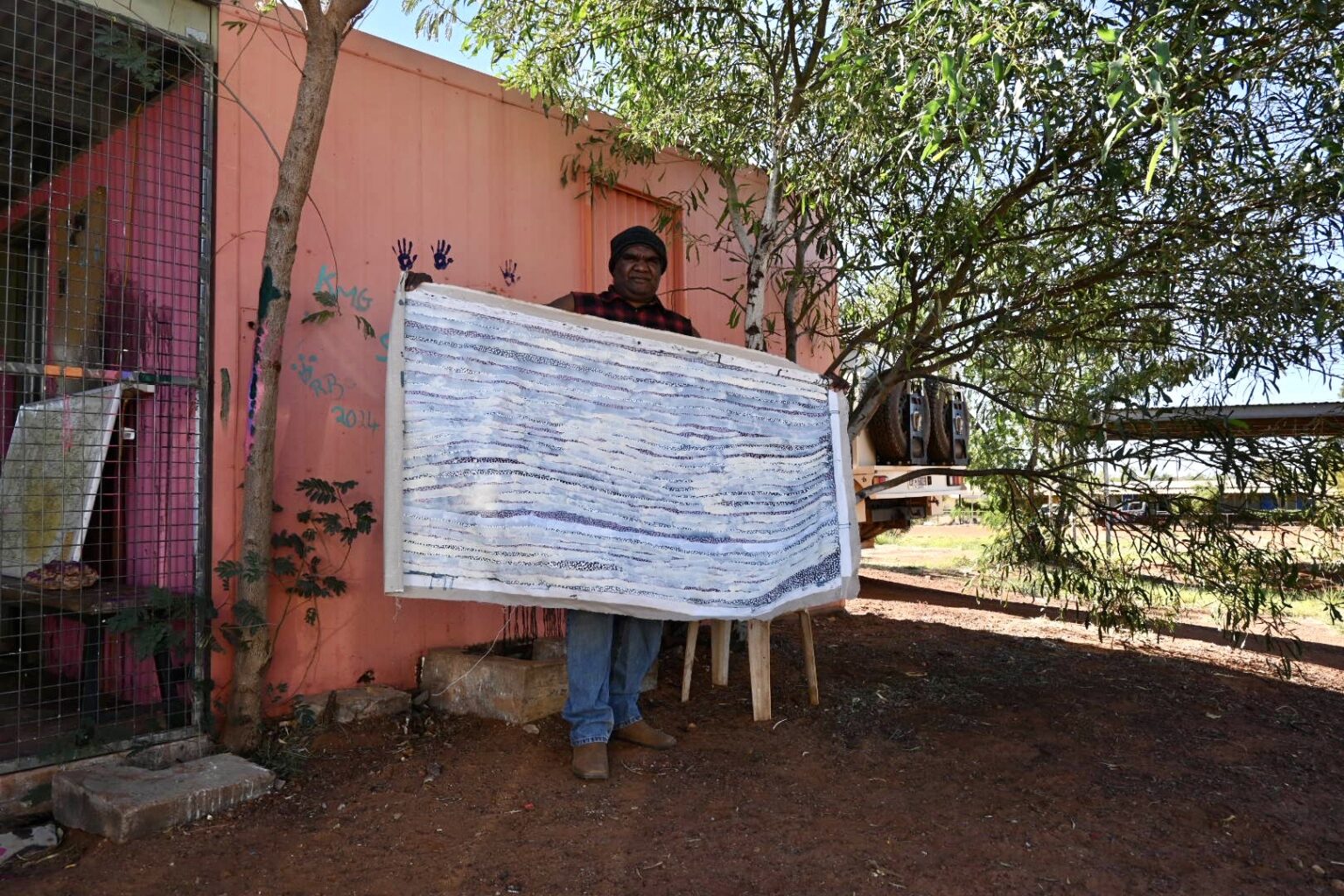
Damien Miller, son of renowned Martu artists M. Miller and N. Chapman. Though he’s only recently begun painting, he’s now making up for lost time, explaining; “Once I started I can’t stop!”
Chatting with Damien over a cuppatea, he reflects on the legacy of his late parents- M. Miller and N. Chapman- and the deep sense of pride and responsibility he feels when painting. For Damien, art is an important way of keeping his family’s ancestral lands alive, often painting to the echo of his mother’s words: “You gotta paint this Country here.” Though he only began painting two years ago, he approaches his artmaking practice with heartfelt dedication and growing confidence.
Damien also shares powerful insight into his parents’ role in establishing Punmu community during the ‘Return to Country’ or ‘Homelands’ movement of the 1980s. During this time, small decentralised communities were founded on ancestral lands, enabling First Nations people to live in closer connection with their culture and traditions following decades of colonisation, forced assimilation, the establishment of missions and reserves, and land dispossession. Damien’s parents were among the first to return to Punmu, helping to build the community from the ground up.
Through his paintings, Damien depicts the Country he knows intimately, having lived there his whole life and learnt about its waterways, bush tucker and jukurrpa (Dreaming) stories from his parents; “I know the Country here- I can picture it.” Having grown up surrounded by his parents’ artwork, Damien appears to have developed an innate understanding of the technical aspects of painting. Sensitive palettes, dynamic compositions, and beautifully varied applications of paint were evident in his earliest works, and continue to deepen as he develops his own distinctive style.
How do you like your tea?
I like it white and no sugar, with a biscuit. I like to have a cuppatea, here in the art centre in Punmu. Sometimes I like a coffee aswell.
Can you tell us a bit about your early history?
I was born in Newman in 1982, and when I was a little baby we was at Camp 61 [an outstation on Bilanooka Station]. There used to be a camp, like a little community there. Then, in the eighties, my parents went back home where they been walking long time [ago] in the pujiman (traditional, desert-dwelling, traditional) days- they took me to Punmu.
When they made a camp here [in Punmu] they got really happy. My dad helped to set things up- they were some of the first people here then, with a lot of other old people, when they built Punmu. My dad was telling me about when they first came, they were grading the road. When they settled in Punmu they was really happy.
I seen them when I was a young boy, set up the new school with lot of old people. Whitefellas were helping the Martu people too. We moved from the bower shed [simple shelters constructed of branches and leaves to provide shade] to the new school. My parents were really happy that we went to school here, grew up here.
Out in Punmu I learned a lot from my parents- they used to take me hunting for goanna, rabbits, wild cats. They learned [taught] me a lot here. We’d go out camping and walking here. They used to tell me stories when we went camping about when they walked around here pujiman time. My dad’s side and mum’s side in pujiman time, they lived separate ways, but they met in Jigalong long time [ago], mission time.
Can you describe your journey as an artist?
I started painting two years ago. Before, when my parents were painting, they asked me “You wanna paint?” and I told them “Nah- it’s boring!” When my dad passed away and my mum was alive, my mum kept asking me “Can you paint?” She told me “When I’m gone, you have to paint all my ngurra (home Country, camp), ngurra and soak, claypans. She was really happy, my mum, when I started. She told me “Yeah, like that! Keep going, keep going!” She was looking at me when I was painting, she was telling me “You gotta paint this one here. You gotta paint my ngurra, not somebody else’s ngurra. You gotta paint this Country here.” She was really happy.
I paint my mum’s Country and my dad’s, but I paint my own style, my own way. I paint a lot- I paint Country, claypans and soaks. I paint about the waterholes, the plants- mix it up, mix it up. If I do claypan or a soak I mix a spinifex colour- I do a birds eye view. I know the Country here- I can picture it. If I go driving or on a plane, I look at it. My mum was always pointing out the water and the soaks. I look at it, see the colours and the spinifex, the sand dunes. I picture it and say to myself “That’s how I gotta paint it here” That’s how I do it!
Mostly I paint here in Punmu or at Martmumili in Newman. It’s good painting with the other artists, yeah. Me and [my wife] Cynthia, we both go there and paint. Cynthia was really happy when I started painting too. And my kids- now I tell them “You gotta paint! Come down to the art centre.” It’s good- keeps me busy, telling stories. I take it home and do it in the night too. Once I started I can’t stop. I love doing painting – it’s good. I wanna start doing bigger ones now- I wanna try that next.
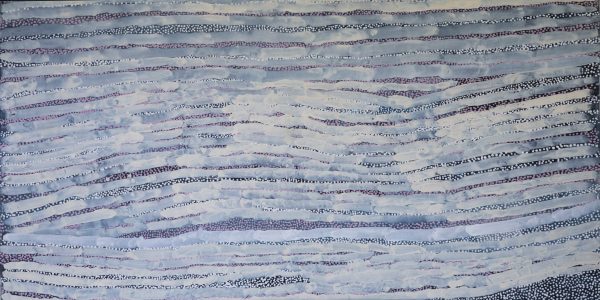
What’s been your most exciting moment as an artist so far?
When I went to Perth for Revealed [annual New and Emerging WA Aboriginal Artists exhibition], I got that really good feeling seeing my painting on the wall for the first time. Me and Cynthia, we both couldn’t believe it. I was thinking about my parents. It made me cry looking at my painting and thinking of my parents. My mum and dad would feel really proud for me. My mum was a role model for me, a mentor. She kept telling me stories about the different places- a lot of places. Half of the places, I’ve been there with her. She wanted me to keep painting her ngurra- keep it alive.
What do you like to do besides painting?
Sometimes I go out on the Country, like ranger work with KJ [cultural and ranger organisation, Kanyirninpa Jukurrpa]. I do work round the community, like whippersnippering, helping with the gardens. I also like going camping, telling stories to Moses- me and Cynthia are the foster parents for him.
– Words by Ruth Leigh in conversation with Damien Miller
